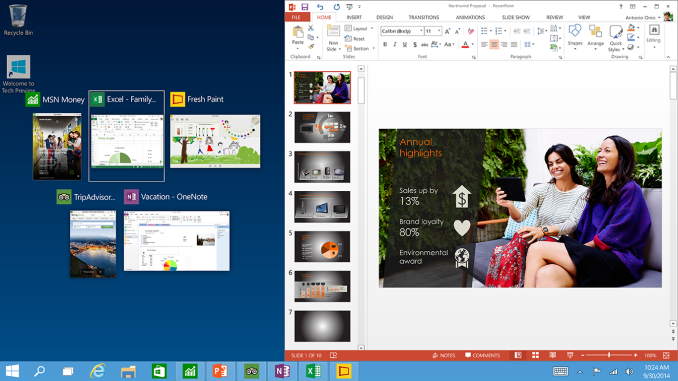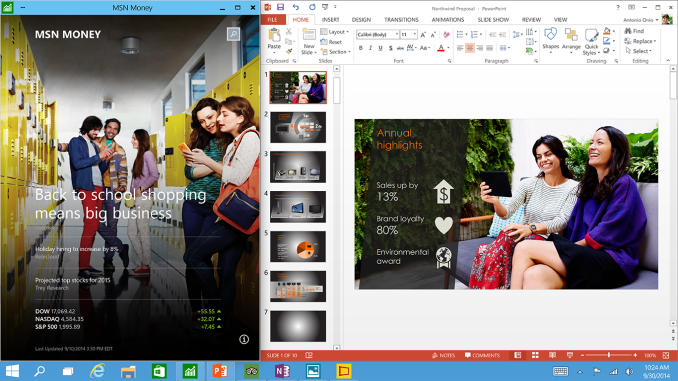Windows 10 Technical Preview First Impressions: The Return Of The Desktop
by Brett Howse on November 13, 2014 8:00 AM EST- Posted in
- Software
- Microsoft
- Windows 10
Closing Thoughts
If Windows 8 was “Touch First” then clearly Windows 10 is not. The current technical preview is very much geared towards the traditional mouse and keyboard user. This will change of course over the next several months, as the touch features get integrated back into Windows 10. As a user of all types of Windows devices, I welcome this change. It allows me to be more productive on my desktop, but still use the touch based Start Screen on a tablet or convertible notebook. Some good things have been done here to hopefully embrace the current user base, as well as new device types.
There are a number of features aimed squarely at businesses. If Microsoft wants to avoid another Windows XP with Windows 7 – where businesses do not migrate until they absolutely have to – then these features are certainly a carrot that may entice them to at least try it out. The Start Menu and other desktop additions will be great for the business users, and I think the IT crowd will be happy with a lot of the new additions around device management, identity management, and information management.
This is a technical preview of course, but still I would be remiss to not mention that it is not without its bugs. I have had a lot of issues with Windows Store apps, with many of them crashing especially when they are not the active window. Possibly there are some changes to the underlying WinRT framework for apps in standby but until we hear more about the framework changes then these problems will likely continue. More of this information should come out around the time of the next BUILD conference, scheduled for April 29th to May 1st 2015. Other issues with WinRT apps currently is that even though they can be used in a window, the absolute height of the window is limited. When Windows 8 was launched, WinRT apps were expecting to be either full screen, or snapped to the side. As such, the apps in a window must maintain a minimum height. Hopefully this can get sorted out in the future.
At first glance, Windows 10 looks like Windows 8 with a Start Menu. It is clearly a lot more than that, but even so, as someone very smart told me, that’s not a bad thing. Windows 8 had a lot going for it, but design decisions were made early on, and with a “my way or no way” attitude that it was difficult to use. It seems that Windows 10 really addresses a lot of this, while at the same time keeping and expanding on a lot of the great features that were in Windows 8 and likely overlooked due to a lot of animosity towards it.
The Windows Store is going to be a big part of this, and if the rumors of desktop apps being integrated into the store is true, then the OOBE for Windows 10 will be amazing. All of your settings and apps will now follow you from device to device, with a single log in. A lot of that is already there with Windows 8, but 10 should finish off the last remaining pieces if this is true. It makes a lot of sense, so unless the licensing terms are awful, this could be a fantastic addition to the store.
The Universal App model is also a big piece of the puzzle, but here there is more work to do. WinRT has a lot of advantages, but the framework needs to be updated at a rapid pace in order to draw developers in. It is somewhat seductive to be able to target desktops, laptops, tablets, phones, and the TV with Xbox One with a single application (with multiple interfaces of course) but until the framework is made powerful enough for more apps than just simple web front ends, it may be difficult to realize this idea. Once again, more info should be available at BUILD in regards to this.
I’ve also had some bugginess with the WinRT apps on Windows 8, which I hope will be fixed with Windows 10. At this point though, the WinRT apps are even buggier so likely there will be more pain before this is all corrected.
Although we have only seen the Technical Preview and a single update to it so far, you can see the potential for Windows 10 and what it will be able to accomplish. It is an ambitious goal to provide a single platform across such a swath of different devices, and one that was held back by the user interface before. With Continuum, it appears that it may be the best of both worlds. Even more exciting is how much more upfront and open Microsoft has been on this entire process, with not just the technical preview but also soliciting and requesting user feedback on the changes. One of the biggest change requests was a simple animation on the Start Menu, and that has already been implemented, so this really is a different world than when Windows 8 was given a sneak peek.
Due to the timing of the latest release that just came out, this article is based on the second build of Windows 10 and I have not had a chance to go over any of the changes in the latest built that arrived on November 12th.
Going forward, as we get more updates to the preview we will do our best to keep you fully informed with that the changes are, and how they will affect you. If you want to kick the tires of Windows 10 and you have not yet, just visit http://preview.windows.com and sign up for the technical preview.












198 Comments
View All Comments
name99 - Saturday, November 15, 2014 - link
If they have any sense they will copy Apple (yet again, adding to the 90% of features that are currently Apple copies) and(a) warn when the user launches code that is unsigned
(b) not allow unsigned code to run without special (not completely obvious) interaction by this user.
This might do one bit more to help limit the spread of malware (especially the stuff that runs as non-obvious apps, like autorun apps on USB, or weird drivers, or stuff that gets downloaded from the net pretending to be a movie).
asmian - Sunday, November 16, 2014 - link
"they will copy Apple (yet again, adding to the 90% of features that are currently Apple copies)"No, you don't get away with that. You mean it's one of the 90% of features that Apple has stolen from others, then claimed to have invented, or fraudulently patented despite years of demonstrable prior art. Apple is the copier, not the innovator, and Jobs admitted it publicly. Some of us are old enough to remember the original Apple vs. MS spat over "look and feel" when Apple tried to prevent Windows from using a GUI at all, despite them having stolen the idea themselves from work done at Xerox Parc...
andrewaggb - Sunday, November 16, 2014 - link
I think you're trolling or you haven't used windows since xp. In my opinion at least, you get sufficient warnings for these activities.WinRT essentially has these restrictions.
DanNeely - Thursday, November 13, 2014 - link
"The Windows Store is going to be a big part of this, and if the rumors of desktop apps being integrated into the store is true, then the OOBE for Windows 10 will be amazing. All of your settings and apps will now follow you from device to device, with a single log in."Just offering desktop apps in the store isn't enough to do that. They also need to:
1) Convince desktop app developers to offer their apps in the store.
2) Allow paid apps originally bought outside of the store to be redistributed within it without requiring the purchase of a new copy.
3) For apps with regular paid upgrades keep all the historic versions available for redownload if a user hasn't bought the upgrade.
4) Find apps installed traditionally when a PC is upgraded and import them into the store system.
5) Provide a scan app that works on Win7/8.x and will generate a Windows store app download list to jumpstart your new Windows 10 system.
kmmatney - Thursday, November 13, 2014 - link
How many Windows "Apps" do people normally buy? I buy games from Steam, but almost all of my Apps are freeware. I buy Apps for my phone,as sometimes they offer a better experience than a webpage, but on a desktop you can just use the browser instead of Apps.Icehawk - Thursday, November 13, 2014 - link
Please tell me W10 will stop asking me to "tap here" when I connect a Bitlocked drive to my desktop... which has no touchscreen. W7's implementation was much better, a normal popup window I could begin typing my password into.mkozakewich - Thursday, November 13, 2014 - link
It's not a sharp difference between "Touch" and "Mouse and Keyboard". Any touch system can have mice and keyboards attached. The mouse and the keyboard are two separate control schemes, too, and each have to be able to work independently.In the first part, you go on at length about how Windows 8 failed from a "Mouse and Keyboard" view. I understand that it was weird to use a mouse before 8.1, but there honestly hasn't really been a change between keyboard use. The Windows key didn't disappear from all the keyboards, nor did it start working. The same commands would switch between windows and close windows. It was still as easy to select things.
It would have been more succinct to say, "Windows 8 designed on-screen interactions for touch, to the detriment of the mouse."
mkozakewich - Thursday, November 13, 2014 - link
Whoops, "nor did it stop working."synoptic12 - Thursday, November 13, 2014 - link
Irrespective of the many view points on the Windows 10 features, the fact remains that the focal point is centered upon a universal value, (Icons) whereas no effort is being infused to use one's mind. The continuum can be considered to simplify the apps for the generation who can not comprehend, or think. Many believe that a network is comprised of magical symbols which really serve no purpose, just delving upon grade school functions. We're not getting smarter, we're moving into a dilemma of lacking any thought.theuglyman0war - Thursday, November 13, 2014 - link
but so many devs can hope to get rich quick now that my gui looks like corporate web advertising. I wonder when the bottom falls out from app selling and App stores if the majority will act like they did not see it coming.